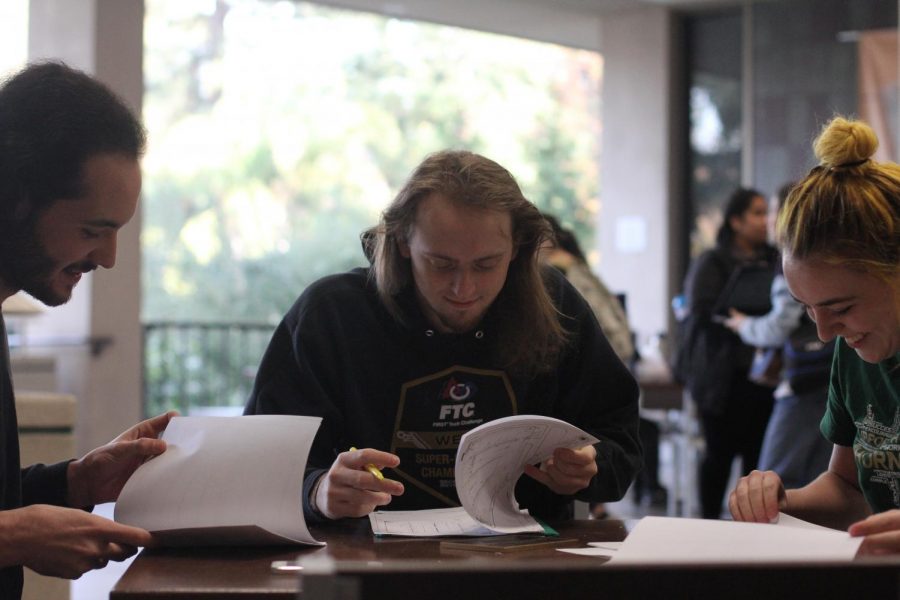Mechanical engineering majors developing parking tracker, set to be available for fall 2018
Thomas Frey – The State Hornet
From left to right, Marco Bonanni, Timothy Hagen and Lauren Rice look over plans for their senior project on Dec. 1. They are among five students working on having parking tracking set up for Lots 9 and 10 by fall 2018.
December 6, 2017
Imagine a 30-minute, traffic-heavy commute, and upon getting to your destination, parking is not readily available. You spend more than 20 minutes driving up and down parking structures and through full lots just to find a spot half a mile away from your class or job.
This is a common experience for anyone who has tried to enter Sacramento State during peak traffic hours, and five mechanical engineering majors hope to find a time-saving solution. As of now, the Sac State parking app displays how many spots are available in the parking garages, but it has its flaws.
“They just have people going out there and seeing how full it is, manually inputting a number every once in awhile,” project member Lauren Rice said. “It’s obvious parking is an issue, we just want to make it a little better, at least.”
The five students, Rice, Marco Bonanni, Timothy Hagen, Caitlin Planchard and Kevin Staebler, want real-time parking statistics to be presented to prospective parkers and plan to make it a reality for Lots 9 and 10 with a parking tracker as their senior project.
Those lots, which are dirt lots, contain 653 and 517 spaces, respectively. The team plans to have the parking tracker launch by the fall 2018 semester.
The students are developing sensors by using Gaussian elimination, an algorithm for solving linear equations. The team credits this to Staebler, whom the team calls an “expert on that algorithm.” Sensors will track when every car enters the lots and whether or not the car parks or leaves. The team said this data will be constantly updated in the Sac State app.
The goal of the project, according to the team, is to allow prospective parkers to use the app to see where spots are available instead of circling the parking lot aimlessly.
This project began at the start of this academic school year, and the group said one of the hardest parts was getting the funding. After three months of applying for grants, UTAPS Director Tony Lucas went on to approve a $3,500 budget for the project.
“We were struggling to find funding for our project,” Rice said. “Tony was our last hope at getting funding. We applied for a few grants but weren’t going to know if we won them until January.”
They got the ball rolling quickly from there and were able to start developing the product and code using software programs like MATLAB and SolidWorks. Bonanni said it has been a process learning laws and regulations and that they will work during winter break to experiment and find the best code to use before installation.
“Jan. 20 is when we will have the code mostly finished by,” Hagen said. “We are going to be doing minor testing to verify everything is mostly working without installing the full system.”
Hagen said that, from there, they will work to perfect their project and complete all of their other project requirements, like writing papers and making a mini-model that will show how the system works before setting everything up.
The team said rolling the app out is just the first step. If successful, the students would like to have more parking areas on campus use this it in the future.
“It’s going to be really expandable as far as the system because we are using this program that all the engineers know how to use and are familiar with,” Bonanni said. “It will be really easy to adjust the code and expand off our project.”
For the team, doing this for their senior project not only could help all students, but could help them relate what they are learning to many different engineering fields.
“Even if we don’t want to go into this discipline of engineering, we’re definitely getting experience with working with actual businesses, expense reports and formal writeups,” Hagen said.
































































































































